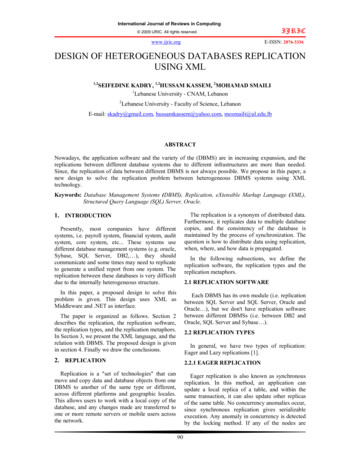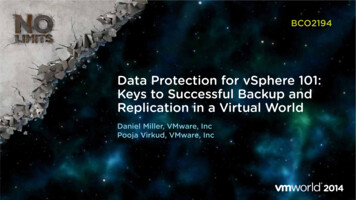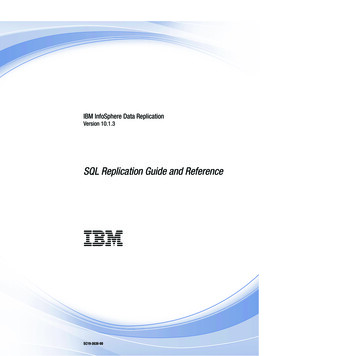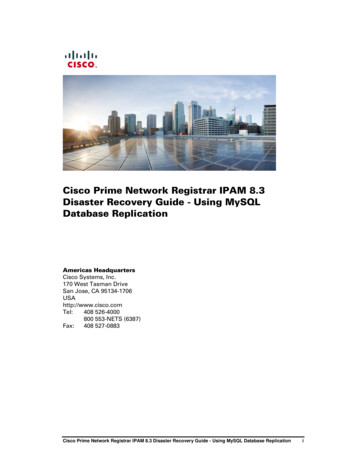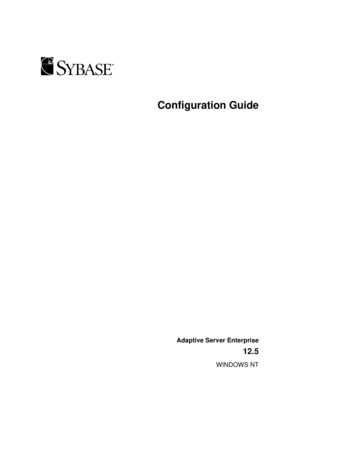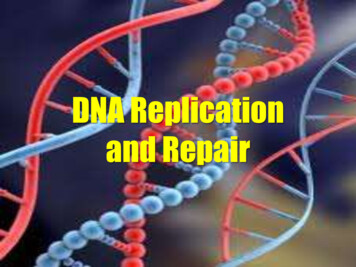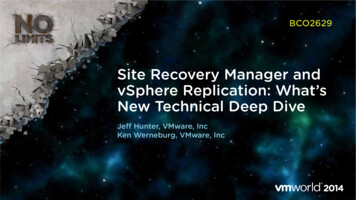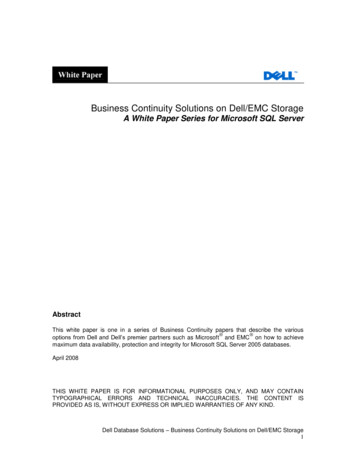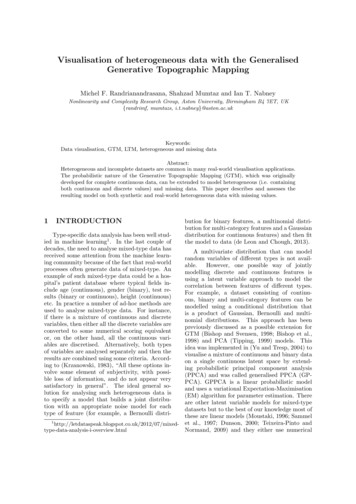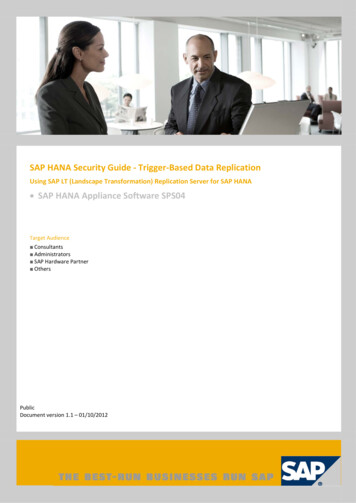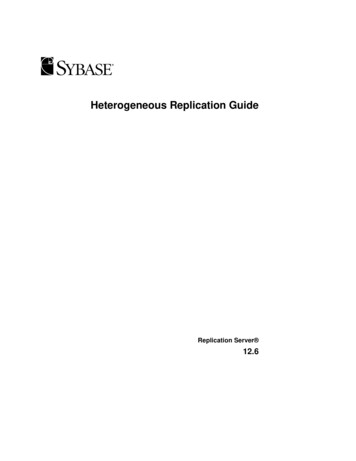
Transcription
Heterogeneous Replication GuideReplication Server 12.6
DOCUMENT ID: DC36924-01-1260-01LAST REVISED: October 2003Copyright 1992-2003 by Sybase, Inc. All rights reserved.This publication pertains to Sybase software and to any subsequent release until otherwise indicated in new editions or technical notes.Information in this document is subject to change without notice. The software described herein is furnished under a license agreement,and it may be used or copied only in accordance with the terms of that agreement.To order additional documents, U.S. and Canadian customers should call Customer Fulfillment at (800) 685-8225, fax (617) 229-9845.Customers in other countries with a U.S. license agreement may contact Customer Fulfillment via the above fax number. All otherinternational customers should contact their Sybase subsidiary or local distributor. Upgrades are provided only at regularly scheduledsoftware release dates. No part of this publication may be reproduced, transmitted, or translated in any form or by any means, electronic,mechanical, manual, optical, or otherwise, without the prior written permission of Sybase, Inc.Sybase, the Sybase logo, AccelaTrade, ADA Workbench, Adaptable Windowing Environment, Adaptive Component Architecture,Adaptive Server, Adaptive Server Anywhere, Adaptive Server Enterprise, Adaptive Server Enterprise Monitor, Adaptive ServerEnterprise Replication, Adaptive Server Everywhere, Adaptive Server IQ, Adaptive Warehouse, Anywhere Studio, ApplicationManager, AppModeler, APT Workbench, APT-Build, APT-Edit, APT-Execute, APT-FORMS, APT-Translator, APT-Library, AvantGo,AvantGo Application Alerts, AvantGo Mobile Delivery, AvantGo Mobile Document Viewer, AvantGo Mobile Inspection, AvantGoMobile Marketing Channel, AvantGo Mobile Pharma, AvantGo Mobile Sales, AvantGo Pylon, AvantGo Pylon Application Server,AvantGo Pylon Conduit, AvantGo Pylon PIM Server, AvantGo Pylon Pro, Backup Server, BizTracker, ClearConnect, Client-Library,Client Services, Convoy/DM, Copernicus, Data Pipeline, Data Workbench, DataArchitect, Database Analyzer, DataExpress, DataServer,DataWindow, DB-Library, dbQueue, Developers Workbench, Direct Connect Anywhere, DirectConnect, Distribution Director, e-ADK,E-Anywhere, e-Biz Integrator, E-Whatever, EC Gateway, ECMAP, ECRTP, eFulfillment Accelerator, Embedded SQL, EMS, EnterpriseApplication Studio, Enterprise Client/Server, Enterprise Connect, Enterprise Data Studio, Enterprise Manager, Enterprise SQL ServerManager, Enterprise Work Architecture, Enterprise Work Designer, Enterprise Work Modeler, eProcurement Accelerator, EWA,Financial Fusion, Financial Fusion Server, Gateway Manager, GlobalFIX, ImpactNow, Industry Warehouse Studio, InfoMaker,Information Anywhere, Information Everywhere, InformationConnect, InternetBuilder, iScript, Jaguar CTS, jConnect for JDBC, MailAnywhere Studio, MainframeConnect, Maintenance Express, Manage Anywhere Studio, M-Business Channel, M-Business Network,M-Business Server, MDI Access Server, MDI Database Gateway, media.splash, MetaWorks, My AvantGo, My AvantGo Media Channel,My AvantGo Mobile Marketing, MySupport, Net-Gateway, Net-Library, New Era of Networks, ObjectConnect, ObjectCycle,OmniConnect, OmniSQL Access Module, OmniSQL Toolkit, Open Biz, Open Client, Open ClientConnect, Open Client/Server, OpenClient/Server Interfaces, Open Gateway, Open Server, Open ServerConnect, Open Solutions, Optima , PB-Gen, PC APT Execute, PCNet Library, PocketBuilder, Pocket PowerBuilder, Power , power.stop, PowerAMC, PowerBuilder, PowerBuilder Foundation ClassLibrary, PowerDesigner, PowerDimensions, PowerDynamo, PowerJ, PowerScript, PowerSite, PowerSocket, Powersoft, PowerStage,PowerStudio, PowerTips, Powersoft Portfolio, Powersoft Professional, PowerWare Desktop, PowerWare Enterprise, ProcessAnalyst,Rapport, Report Workbench, Report-Execute, Replication Agent, Replication Driver, Replication Server, Replication Server Manager,Replication Toolkit, Resource Manager, RW-DisplayLib, S-Designor, SDF, Secure SQL Server, Secure SQL Toolset, Security Guardian,SKILS, smart.partners, smart.parts, smart.script, SQL Advantage, SQL Anywhere, SQL Anywhere Studio, SQL Code Checker, SQLDebug, SQL Edit, SQL Edit/TPU, SQL Everywhere, SQL Modeler, SQL Remote, SQL Server, SQL Server Manager, SQL SMART,SQL Toolset, SQL Server/CFT, SQL Server/DBM, SQL Server SNMP SubAgent, SQL Station, SQLJ, STEP, SupportNow, S.W.I.F.T.Message Format Libraries, Sybase Central, Sybase Client/Server Interfaces, Sybase Financial Server, Sybase Gateways, Sybase MPP,Sybase SQL Desktop, Sybase SQL Lifecycle, Sybase SQL Workgroup, Sybase User Workbench, SybaseWare, Syber Financial,SyberAssist, SyBooks, System 10, System 11, System XI (logo), SystemTools, Tabular Data Stream, TradeForce, Transact-SQL,Translation Toolkit, UltraLite.NET, UNIBOM, Unilib, Uninull, Unisep, Unistring, URK Runtime Kit for UniCode, Viewer, VisualComponents, VisualSpeller, VisualWriter, VQL, WarehouseArchitect, Warehouse Control Center, Warehouse Studio, WarehouseWORKS, Watcom, Watcom SQL, Watcom SQL Server, Web Deployment Kit, Web.PB, Web.SQL, WebSights, WebViewer, WorkGroupSQL Server, XA-Library, XA-Server and XP Server are trademarks of Sybase, Inc. 03/03Unicode and the Unicode Logo are registered trademarks of Unicode, Inc.All other company and product names used herein may be trademarks or registered trademarks of their respective companies.Use, duplication, or disclosure by the government is subject to the restrictions set forth in subparagraph (c)(1)(ii) of DFARS 52.227-7013for the DOD and as set forth in FAR 52.227-19(a)-(d) for civilian agencies.Sybase, Inc., One Sybase Drive, Dublin, CA 94568.
ContentsAbout This Book . ixPART 1INTRODUCTIONCHAPTER 1Sybase Replication System Overview .Basic replication concepts.Heterogeneous replication .Replication system components.Primary data server .Replication Agent .Replication Server .Database gateway.Replicate data server .Replication Server Manager .CHAPTER 2CHAPTER 33346667889Sybase Replication Tools.Sybase replication technology .Replication Server .Replication Agents .DirectConnect database gateways .Replication Server Manager.1112151819Heterogeneous Replication Issues .Overview of heterogeneous replication issues.Heterogeneous replication limitations .Stored procedure replication .Owner-qualified object names.Large object replication .Setting up replicate databases .Subscription materialization .Replication Server rs dump command .Replication Server rs marker command .212324242527282829Heterogeneous Replication Guide1121iii
ContentsReplication Server rs dumptran command . 29Replication Server rs subcmp utility . 30PART 2COMPONENT-SPECIFIC ISSUESCHAPTER 4Data Server Issues. 33Primary data servers . 33DB2 Universal Database primary data servers . 34Informix Dynamic Server primary data servers . 49Microsoft SQL Server primary data servers . 56Oracle primary data servers . 63Replicate data servers . 72DB2 Universal Database replicate data servers. 72Informix Dynamic Server replicate data servers. 83Microsoft SQL Server replicate data servers. 88Oracle replicate data servers . 94Component Integration Services . 99CHAPTER 5Replication Server Issues .Relationship with other system components.Relationship with Replication Agents .Database connections.Rep Agent User thread.DSI thread .Replication Agent connections .DirectConnect database gateways.Maintenance User .Replication Server heterogeneous datatype support .Datatype translation .HDS issues and limitations.Emulating rs init activity for a non-Sybase database .Case sensitivity in publications and subscriptions .PART 3IMPLEMENTING HETEROGENEOUS REPLICATIONCHAPTER 6Using RSM to Set Up Replication Systems.Introduction to Replication Server Manager.Setting up a heterogeneous replication system .Replication system configuration options .DB2 Universal Database for OS/390 12115115116122125131131133133136Replication Server
ContentsSetting up Replication Server.Setting up a replicate database with HDS scripts .Setting up a Replication Agent .Setting up a non-Sybase data server with RSM.Creating a database connection.Resuming a database connection .138141141143144146CHAPTER 7Replication System Configuration Examples.Non-Sybase primary to Adaptive Server replicate .Replication system components.Replication system issues .Adaptive Server primary to non-Sybase replicate.Replication system components.Replication system issues .Non-Sybase primary to non-Sybase replicate.Replication system components.Replication system issues .Bidirectional non-Sybase to non-Sybase replication.Replication system components.Replication system issues .147147147148148148149150150150152152152CHAPTER 8Administering Heterogeneous Replication Systems.Replication system maintenance .Primary data servers and Replication Agents .Replication Server .Replicate data servers and DirectConnect gateways.Replication system monitoring .Replication system monitoring overview .Monitoring non-Sybase heartbeat and latency.Troubleshooting non-Sybase heartbeat and latency.155155155156156157157158160CHAPTER 9Troubleshooting Heterogeneous Replication Systems .Troubleshooting overview .Inbound and outbound queue problems .Inbound queue problems.Outbound queue problems.Replication failure problems.Trigger-based logging failures.Replicate database is not updated .Troubleshooting specific errors .Date information does not include time values.Updates to rs lastcommit fail .163163164164166168168169171171171Heterogeneous Replication Guidev
ContentsExpected datatype translations do not occur .Replication Agent triggers do not fire .Determining log scan position .LTL generation and tracing .172174176176PART 4APPENDIXESAP PE ND IX ADatatype Translation and Mapping .DB2 datatypes.DB2 class-level translations .Replication Server datatype names for DB2 .Informix datatypes.Informix class-level translations .Replication Server datatype names for Informix .Microsoft SQL Server datatypes .Microsoft SQL Server class-level translations.Replication Server datatype names for Microsoft SQLServer .Oracle datatypes .Oracle class-level translations.Replication Server datatype names for Oracle.192192192195Materialization Issues .Materialization overview .Unloading data from a primary database .Datatype translation issues .Loading data into replicate databases .Atomic bulk materialization .Preparing for materialization .Performing atomic bulk materialization .Nonatomic bulk materialization .Preparing for materialization .Performing nonatomic bulk materialization .197199199201202202203205205206AP PE ND IX B183184184186187187189190190197AP PE ND IX CHeterogeneous Database Reconciliation . 209Sybase rs subcmp utility . 209Database comparison application . 210AP PE ND IX DReplication with Adaptive Server Anywhere. 213ASA primary data servers . 213ASA replicate data servers. 216viReplication Server
ContentsGlossary . 219Index . 235Heterogeneous Replication Guidevii
ContentsviiiReplication Server
About This BookSybase Replication Server maintains replicated data at multiple siteson a network. Organizations with geographically distant sites can useReplication Server to create distributed database applications with betterperformance and data availability than a centralized database system canprovide.This book introduces heterogeneous replication concepts, and it addressesthe issues peculiar to heterogeneous replication with Sybase replicationtechnology.In this book, the term heterogeneous replication refers to replicationbetween different types of data servers (for example, replicating from anInformix database to a Sybase Adaptive Server Enterprise database).This book also addresses the issues involved with replication betweennon-Sybase data servers of the same type (for example, replicating fromone Oracle database to another Oracle database).AudienceThe Replication Server Heterogeneous Replication Guide is for anyonewho needs to plan, design, implement, or maintain a Sybase replicationsystem with heterogeneous or non-Sybase data servers.If you are new to Replication Server, refer to the Replication ServerDesign Guide for an introduction to basic data replication concepts andSybase replication technology.How to use this bookThis book is divided into four parts: Heterogeneous Replication GuidePart 1, “Introduction,” provides an overview of data replicationconcepts and Sybase replication technology, and it introduces theissues specific to replication systems with heterogeneous or nonSybase data servers. It contains the following chapters: Chapter 1, “Sybase Replication System Overview,” introducesreplication system concepts, with a focus on heterogeneousreplication using Sybase replication technology. Chapter 2, “Sybase Replication Tools,” introduces the Sybasesoftware products that you can use to implement a replicationsystem with heterogeneous or non-Sybase data servers.ix
Part 2, “Component-Specific Issues,” describes the issues you mustconsider for each component of a heterogeneous replication system, andexplains how to address those issues. It contains the following chapters: Chapter 4, “Data Server Issues,” describes the issues andconsiderations for specific non-Sybase data servers in a Sybasereplication system. Chapter 5, “Replication Server Issues,” describes the issues related tousing Sybase Replication Server in a replication system withheterogeneous or non-Sybase data servers.Part 3, “Implementing Heterogeneous Replication,” describes how to setup and maintain a replication system using Replication Server withheterogeneous or non-Sybase data servers. It contains the followingchapters: Chapter 6, “Using RSM to Set Up Replication Systems,” introducesthe Replication Server Manager (RSM) and describes how to use itto set up a replication system. Chapter 7, “Replication System Configuration Examples,” describesseveral configuration options for a Sybase replication system withheterogeneous or non-Sybase data servers, and explains the issuesinvolved with each configuration. Chapter 8, “Administering Heterogeneous Replication Systems,”describes administration tasks for replication systems withheterogeneous or non-Sybase data servers. Chapter 9, “Troubleshooting Heterogeneous Replication Systems,”describes common problems and troubleshooting procedures forreplication systems with heterogeneous or non-Sybase data servers.Part 4, “Appendixes,” contains supplemental information in the followingappendixes: xChapter 3, “Heterogeneous Replication Issues,” describes the issuesand problems that are peculiar to heterogeneous replication, and thatmust be addressed in a successful replication system.Appendix A, “Datatype Translation and Mapping,” lists the classlevel datatype translations for all non-Sybase data servers supportedby Replication Server, and lists Replication Server datatype names fornon-Sybase datatypes.Replication Server
About This BookRelated documents Appendix B, “Materialization Issues,” describes the materializationissues that you need to consider when implementing a replicationsystem with heterogeneous or non-Sybase data servers. Appendix C, “Heterogeneous Database Reconciliation,” describesthe issues involved with reconciling data from different databases ina replication system with heterogeneous or non-Sybase data servers. Appendix D, “Replication with Adaptive Server Anywhere,”describes primary and replicate data server issues for Adaptive ServerAnywhere in a Sybase replication system.The Sybase Replication Server documentation set consists of the following: The release bulletin for your platform – contains last-minute informationthat was too late to be included in the books.A more recent version of the release bulletin may be available on theWorld Wide Web. To check for critical product or document informationthat was added after the release of the product CD, use the SybaseTechnical Library. Installation Guide for your platform – describes installation and upgradeprocedures for all Replication Server and related products. What’s New in Replication Server? – describes the new features inReplication Server version 12.6 and the system changes added to supportthose features. Administration Guide – contains an introduction to replication systems.This manual includes information and guidelines for creating andmanaging a replication system, setting up security, recovering fromsystem failures, and improving performance. Configuration Guide for your platform – describes configurationprocedures for all Replication Server and related products, and explainshow to use the rs init configuration utility. Design Guide – contains information about designing a replication systemand integrating heterogeneous data servers into a replication system. Getting Started with Replication Server – provides step-by-stepinstructions for installing and setting up a simple replication system. Heterogeneous Replication Guide – describes how to use ReplicationServer to replicate data between databases supplied by different vendors. Reference Manual – contains the syntax and detailed descriptions ofReplication Server commands in the Replication Command LanguageHeterogeneous Replication Guidexi
(RCL); Replication Server system functions; Sybase Adaptive Servercommands, system procedures, and stored procedures used withReplication Server; Replication Server executable programs; andReplication Server system tables.Other sources ofinformation System Tables Diagram – illustrates system tables and their entityrelationships in a poster format. Available only in print version. Troubleshooting Guide – contains information to aid in diagnosing andcorrecting problems in the replication system. Replication Server plug-in help, which contains information about usingSybase Central to manage Replication Server.Use the Sybase Getting Started CD, the Sybase Technical Library CD and theTechnical Library Product Manuals Web site to learn more about your product: The Getting Started CD contains release bulletins and installation guidesin PDF format, and may also contain other documents or updatedinformation not included on the Technical Library CD. It is included withyour software. To read or print documents on the Getting Started CD youneed Adobe Acrobat Reader (downloadable at no charge from the AdobeWeb site, using a link provided on the CD). The Technical Library CD contains product manuals and is included withyour software. The DynaText reader (included on the Technical LibraryCD) allows you to access technical information about your product in aneasy-to-use format.Refer to the Technical Library Installation Guide in your documentationpackage for instructions on installing and starting the Technical Library. The Technical Library Product Manuals Web site is an HTML version ofthe Technical Library CD that you can access using a standard Webbrowser. In addition to product manuals, you will find links toEBFs/Updates, Technical Documents, Case Management, Solved Cases,newsgroups, and the Sybase Developer Network.To access the Technical Library Product Manuals Web site, go to ProductManuals at http://www.sybase.com/support/manuals/.Sybase certificationson the WebTechnical documentation at the Sybase Web site is updated frequently. Finding the latest information on product certifications1xiiPoint your Web browser to Technical Documents ion Server
About This Book 2Select Products from the navigation bar on the left.3Select a product name from the product list and click Go.4Select the Certification Report filter, specify a time frame, and click Go.5Click a Certification Report title to display the report.Creating a personalized view of the Sybase Web site (including supportpages)Set up a MySybase profile. MySybase is a free service that allows you to createa personalized view of Sybase Web pages.1Point your Web browser to Technical Documents athttp://www.sybase.com/support/techdocs/.2Click MySybase and create a MySybase profile.Sybase EBFs andsoftwaremaintenance ConventionsFinding the latest information on EBFs and software maintenance1Point your Web browser to the Sybase Support Page athttp://www.sybase.com/support.2Select EBFs/Maintenance. Enter user name and password information, ifprompted (for existing Web accounts) or create a new account (a freeservice).3Select a product.4Specify a time frame and click Go.5Click the Info icon to display the EBF/Maintenance report, or click theproduct description to download the software.The following style conventions are used in this manual: In a sample screen display, commands that you should enter exactly asshown are in:this font In a sample screen display, words that you should replace with theappropriate value for your installation are shown in:this fontHeterogeneous Replication Guidexiii
In the regular text of this document, the names of files and directoriesappear like this:/usr/u/sybase In the regular text of this document, the names of programs, utilities,procedures, and commands appear like this:bcpThe conventions for syntax statements in this manual are as follows:Table 1: SQL syntax conventionsKeycommandvariable{ }[ ]( ) ,If you need helpxivDefinitionCommand names, command option names, utility names, utilityflags, and other keywords.Variables, or words that stand for values that you fill in.Curly braces indicate that you must choose at least one of theenclosed options. Do not include braces in your option.Brackets mean that choosing one or more of the enclosed options isoptional. Do not include brackets in your option.Parentheses are to be typed as part of the command.The vertical bar means you can select only one of the options shown.The comma means you can choose as many of the options shown asyou like, separating your choices with commas that you type as partof the command.Each Sybase installation that has purchased a support contract has one or moredesignated people who are authorized to contact Sybase Technical Support. Ifyou cannot resolve a problem using the manuals or online help, please have thedesignated person contact Sybase Technical Support or the Sybase subsidiaryin your area.Replication Server
PA RT1IntroductionChapters in this part introduce some data replicationconcepts and the Sybase replication technology thatsupports replication systems with heterogeneous or nonSybase data servers. Chapter 1, “Sybase Replication System Overview,”introduces basic replication system concepts, with afocus on heterogeneous replication using Sybasereplication technology. Chapter 2, “Sybase Replication Tools,” introduces theSybase software products that enable you to implementa heterogeneous replication system using Sybasereplication technology. Chapter 3, “Heterogeneous Replication Issues,”describes the issues and problems that are specific toheterogeneous replication and that must be addressedin a successful heterogeneous replication system.
CH A PTE R1Sybase Replication SystemOverviewThis chapter introduces some basic, replication system concepts, with afocus on heterogeneous replication using Sybase replication technology.TopicBasic replication conceptsHeterogeneous replicationPage34Replication system components6Basic replication conceptsA basic Sybase replication system consists of three components: Primary database – a database in which original data-changingoperations (or transactions) are performed and captured forreplication Replication Server – a Sybase Open Client/Server product thatreceives transactions to be replicated from a primary database, anddelivers them to a replicate database Replicate database – a database that receives
Audience The Replication Server Heterogeneous Replication Guide is for anyone who needs to plan, design, implement, or maintain a Sybase replication system with heterogeneous or non-Sybase data servers. If you are new to Replication Server, refer to the Replication Server Design Guide for an introduction to basic data replication concepts and
